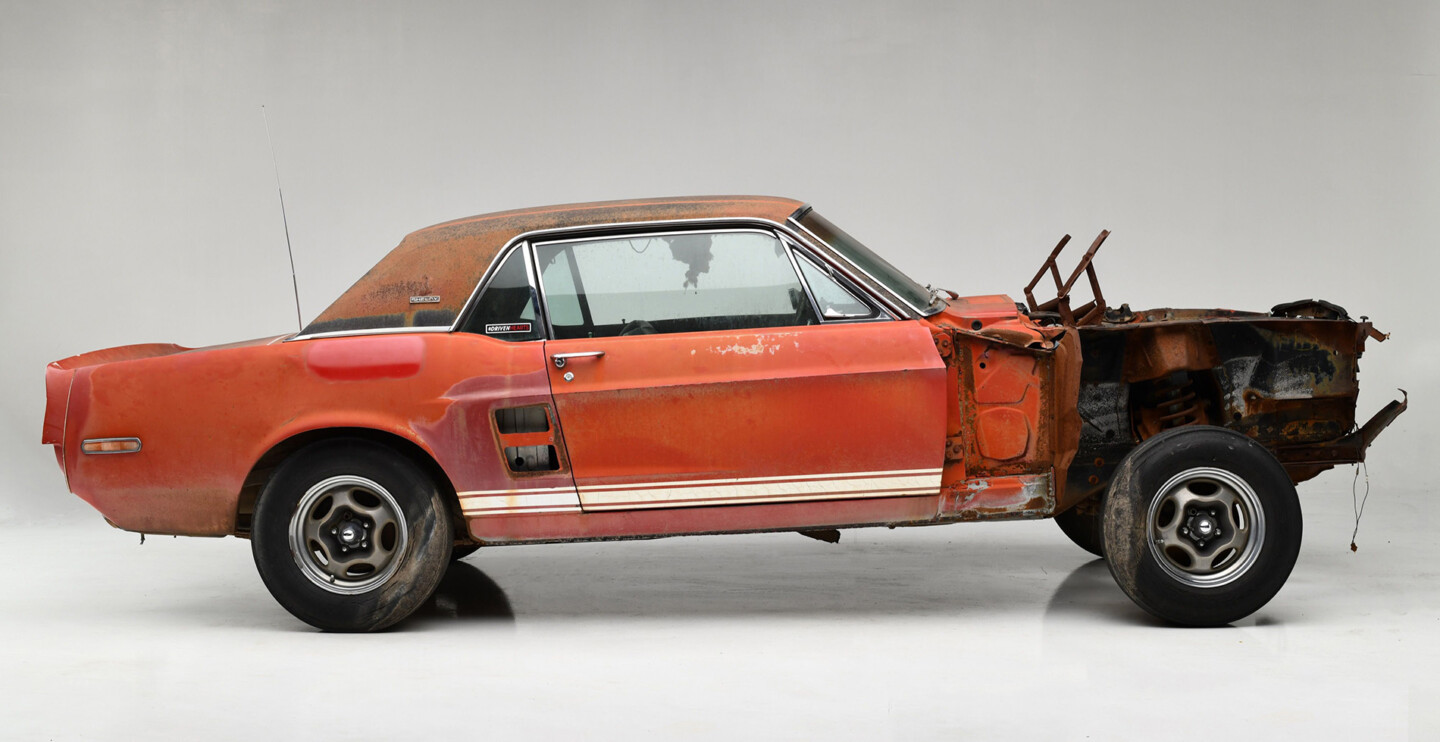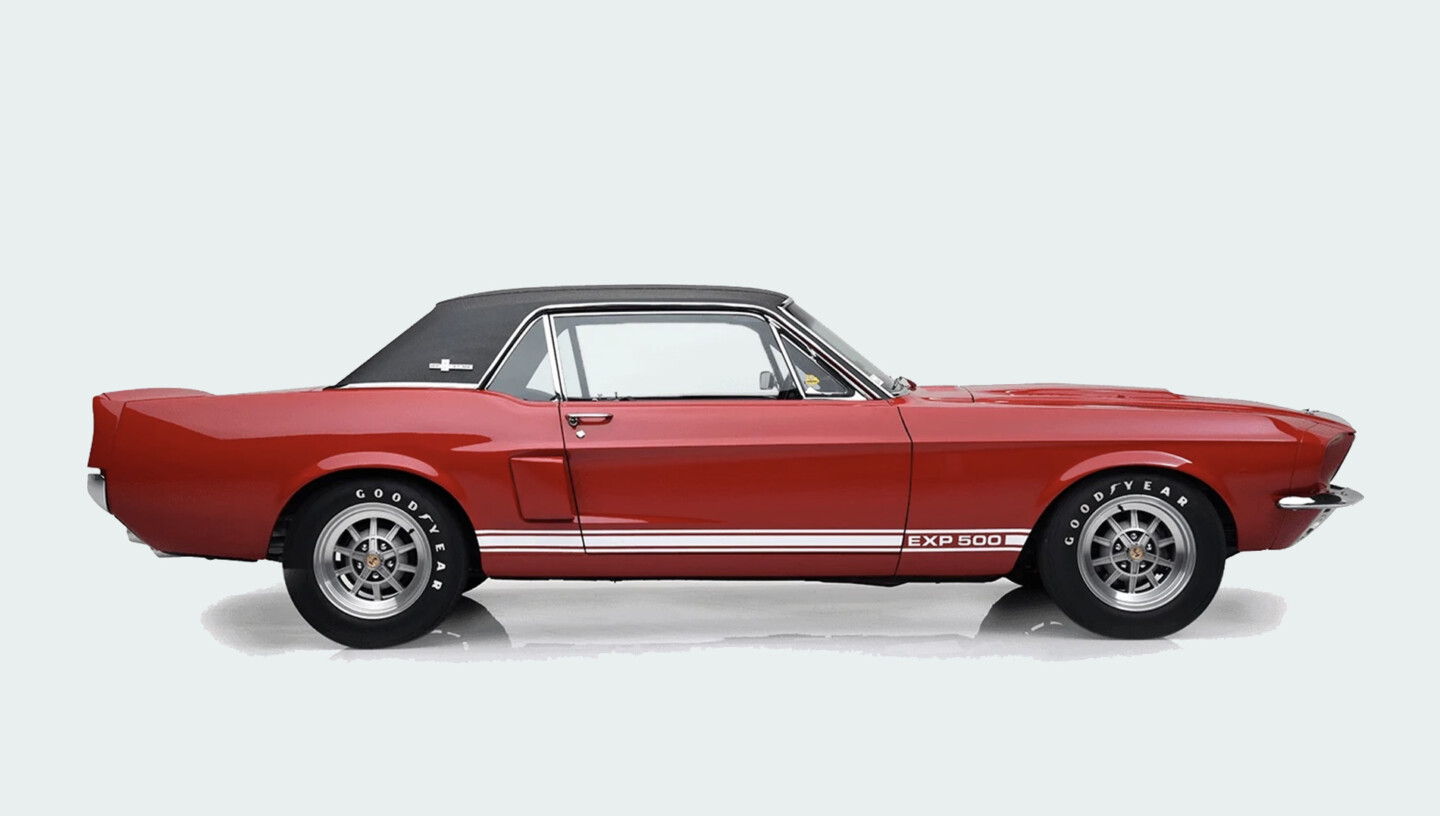If I were to pose the query “what is the most iconic American car in history?” how would you answer? The 1957 Chevy Bel Air? The ’59 Cadillac Eldorado Biarritz convertible? Or perhaps the ’63 Split-Window Corvette?
All, of course, would be excellent answers and could indeed fit the bill. If you ask me though, no American vehicle is more instantly recognizable and venerated than the Ford Mustang.
From the original 1964 ½ iteration that caused a paradigm shift in the automotive market by virtue of more than 418,000 units being sold in its first 12 months, to late model examples packed with technology and possessing advanced aerodynamics, the Mustang has always been unlike anything else on the road.

Ford vice-president Lee Iacocca (second from right) at the reveal of the 1964 ½ Ford Mustang at the New York World’s Fair. (Photo courtesy of the Ford Motor Company.)
Ford vice-president, Lee Iacocca, who had shepherded the Mustang into existence, had stated at car’s reveal during the New York World’s Fair in April of 1964 that the Mustang would be a high-performance vehicle, capable of both street and racing use.
In actuality though, the Mustang lacked chops both in terms of power and handling prowess to qualify as a true sports car, and, because of this, the automotive press began using a new moniker to describe the Mustang: a pony car. In order to fulfill his initial promise, Iacocca was forced to find an outside contractor who could modify the car and transform it into a bona fide performance vehicle.
His pick? Carroll Shelby, who already had an association with Ford through his use of the company’s engines in his legendary Cobra roadsters and by helping to develop the GT40 race car that would go on to beat Ferrari at Le Mans in 1966. As such, he and his company, Shelby American, were the obvious choice for Iacocca.
The union of these two fabled companies would once again yield an exemplar of the performance car world: the Shelby Mustang.
Rare beasts to begin with, there have been a few Shelby Mustang models whose production numbers have been low enough to put them amongst the scarcest muscle cars of all time.
In this installment of Rare Rides though, we’re going to have a look at a true unicorn. The car I’m referring to is the one of one 1967 Shelby GT500 EXP Prototype Coupe, affectionately known as “Little Red,” that served as one of the test mules for the second generation Shelby Mustang.
The first incarnation of the Shelby, the 1965 GT350, would be very close to Lee Iacocca’s original vision for the Mustang. Truly a vehicle that could be driven to the track and then raced, it was a raucous, no-compromise performance car.
At his facility in Venice, California, Shelby had equipped standard Mustang fastbacks supplied by Ford with K-code 289 cubic-inch V8s featuring Holley four-barrel 715-cfm carbs, Cobra Hi-Rise manifolds, cast-aluminum valve covers, and oil sumps, larger radiators, and tubular Tri-Y exhaust headers featuring short side pipes. This bumped horsepower to a stated and vastly underrated 306 ponies.
Four-speed, Borg-Warner T10 all-synchro transmissions with close ratios housed in aluminum cases and tail shafts were fitted, along with ratchet-type limited-slip differentials. Other Shelby goodies included Koni adjustable shocks, more robust anti-sway bars, beefier rear axles from the Ford Galaxie, and Kelsey-Hayes front disc brakes.
External mods consisted of a fiberglass hood with functional hood scoop and hold-down pins, a revised grille, and 15-inch Kelsey-Hayes mag wheels. The cars were only offered in Wimbledon White with Guardsman Blue rocker panel stripes. Roughly twenty-eight percent of the cars came with matching Le Mans-style racing stripes over the top.
The GT350 made its public debut in January of 1965, and a total of 562 cars were built that year, including 34 “R” models aimed at road course racing.
1966 was largely a continuation year for the GT350 with only minor changes. 1967, however, would prove to be anything but.
Ford had restyled the Mustang, making it both larger and heavier. Carroll Shelby saw this change as an opportunity to make the Shelbys’ aesthetics markedly distinct from their lesser Mustang brethren, something he had wanted to do but could not with the ’65-’66 cars due to budget and time constraints. He also felt that the time was right to expand the Shelby Mustang line and add a big-block model, to be christened the GT500, alongside the GT350, and to offer them as coupes and convertibles in addition to the fastback.
In order to do all of this though, he would need to acquire examples of Ford’s new, redesigned Mustang to serve as test mules for the parts that Shelby American would be fitting to its cars.
In July of 1966, Shelby ordered three new ’67 Mustang GTs to serve as prototypes for his planned, big-block GT500 car. One was a fastback, and the other two consisted of a convertible and a notchback coupe. The coupe, in particular, was unusual in a few regards.

The 1967 Shelby GT500 EXP notchback coupe prototype, shortly after it had been transformed from a 428 cubic-inch powered Mustang GT at Shelby’s facilities. (Photo courtesy of Martyn L. Schorr.)
Instead of the typical body-in-white that all previous Mustangs that were sent to Shelby wore, it was delivered wearing Code T Candy Apple Red paint, an eye-popping color that immediately led to the car’s nickname, “Little Red” around the Shelby American facility.
The car was also outfitted with a spray-on black vinyl top, black mouton carpets, and a black Connolly leather interior, one of just two Mustangs that would become Shelbys ever upholstered that way (the convertible, delivered at the same time, had the leather interior too.)
None of the three cars arrived with either of the two standard engines the ’67 Mustang came with – the venerable 289 cubic-inch V8, or the optional 390 cubic-inch mill – but instead had factory-installed FE-series 428 Police Interceptor V8s with 600-cfm Holley dual quad carburetors atop cast-aluminum medium-rise intake manifolds raided from Ford’s 427. Previous to this, all the cars Ford sent had standard Mustang engines, which were then pulled at Shelby American and replaced with the K-code 289s.

A big 428 cubic-inch Police Interceptor V8 like the one fitted in the notchback coupe that would become Little Red. (Photo courtesy of Mecum Auctions.)
Behind the engine in Little Red was a three-speed C6 automatic transmission in lieu of the 4-speed manual all Shelby cars had been equipped with until this point. Further equipment that the car came with included air conditioning, tinted glass, and a remote mirror.
Upon its arrival at Shelby American, chief engineer, Fred Goodell, supervised Little Red’s transformation from a Mustang into a Shelby prototype.
It was outfitted with bespoke fiberglass body pieces, including a gorgeous, elongated nose, a one-off vented hood with twin, functional scoops, and two body side intakes located along the car’s flanks ahead of the rear wheels. A fiberglass tail featured an integral spoiler and sequential taillamps pilfered from the Mercury Cougar. Twin, round, high-beam headlights were mounted in the center of the grille, while a set of white rocker stripes bearing “EXP 500” callouts were added to Little Red’s flanks.

A vintage photo of Little Red’s engine sporting a single Paxton supercharger on the driver’s side. (Photo courtesy of Performance.Ford.com)
Many mechanical components and powertrains were installed and then taken off Little Red during the course of its use as a prototype, but the most dramatic were a Paxton supercharger, and later, a pair of Paxton superchargers. Although they added a tremendous amount of power, the torque produced by the latter setup exceeded what the transmission could handle, and at least one, if not two, were destroyed during testing.
After extensive trials with Little Red and the experimental convertible, Ford and Shelby American ultimately decided that the GT500 would only be produced in the fastback form we all now know and love, although a ragtop would be produced in 1968. Thus, Little Red, the lone 1967 coupe, was shipped to Kar Kraft, the specialty speed shop that served to modify later Ford products such as the Boss 429, where it again served as a test mule for a time.
Like most experimental prototypes of the period, Little Red was then set to be crushed, but no records ever survived as to whether this was actually carried out or not. Over the next 50 years, Little Red was largely forgotten, save for an occasional rumor of its survival that surfaced every so often, sending a small handful of Shelby enthusiasts on periodic and unsuccessful wild goose chases to find it.
Flash forward all the way to 2018. Craig Jackson, Chairman and CEO of Barrett-Jackson Auctions, was deep into the process of restoring another famous Shelby prototype, a gold-luster green 1968 GT500 notchback coupe known as the “Green Hornet,” when the topic of Little Red came up in conversation with Jason Billups, the owner of Billups Classic Cars and Auto Body, who was rebuilding Jackson’s car.
The two men went back and forth, discussing all of the various theories about Little Red’s final disposition, with Billups believing that the car likely still existed and could be located. Jackson, loving the idea of such a challenge, dared Billups to find it.
Remarkably, by force of exhaustive research and a smidgen of luck, Little Red was discovered to still be in existence and located in a field in rural Texas where it had been stored for over twenty years by the same owner.
On March 3rd, 2018, Jackson and a host of experts including renowned Ford Mustang historian, Kevin Marti, went to Texas and verified that the car, which was in terrible condition, was indeed Little Red.
The car was missing its entire front fascia and hood, the suspension had rusted completely, and the body and interior had suffered serious deterioration sitting under the Texas sun for two decades. Nonetheless, Jackson purchased the car and had it brought to Billups Classic Cars.
Before undertaking the restoration, Jackson and Billups were faced with the unusual problem of deciding what configuration to restore Little Red to, since during its life as a prototype it sported different powertrains, transmissions, suspension parts, and bodywork items, unlike a regular car that you would normally just restore to factory spec.
In the end, they decided to bring Little Red back to its most formidable iteration – packing twin Paxton superchargers, a beefed up transmission and cast-iron Lincoln tail-housing, a 9″ rear containing 4.30:1 gears, the vented hood and outboard grille lights (which had been moved by Goodell from the center during the testing of the twin supercharged setup to facilitate better airflow to the radiator), and GT350R racing type lap belts.

The recreated twin Paxton supercharged 428 Police Interceptor V8. (Photo courtesy of Barrett-Jackson Auctions.)
After an exacting, two-year-long, nut-and-bolt restoration based on the original Shelby schematics and recollections of many who originally built and tested it in 1967, Little Red was brought to concours condition, including that twin Paxton supercharged mill which pushed out 594 horsepower and 640 lb-ft of torque on a dyno.
In a truly triumphant moment for all Shelby enthusiasts, Little Red made its public debut in restored form alongside a fully refreshed Green Hornet at a Barrett-Jackson event on January 16th, 2020. It was possibly the first instance in which two of the most illustrious Shelby Rare Rides of all time had shared the same stage.


























